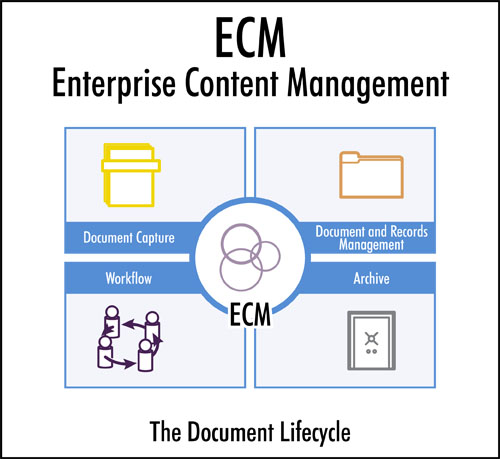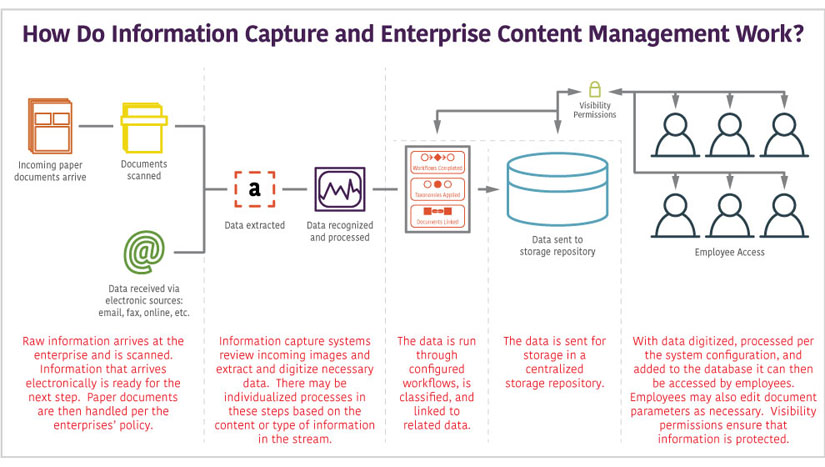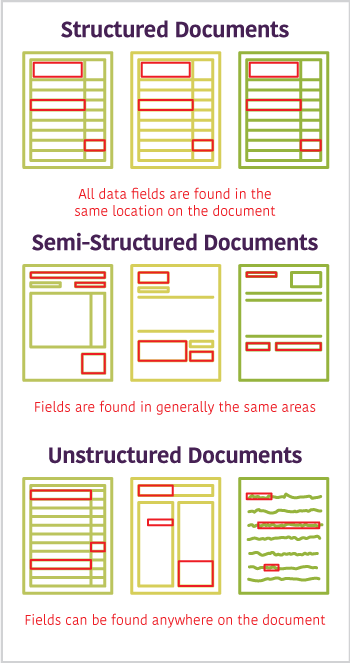What is Enterprise Content Management (ECM) and how does it benefit organizations?
![]() Enterprise content management (ECM) is a form of content management that combines the capture, search, and networking of documents with digital archiving, document management, and workflow. The special challenge of managing and using all forms of a company's internal information (which is often unstructured) is what sets enterprise content management apart from other forms of content management. Because of this, most ECM solutions on the market today focus on business-to-employee (B2E) use.
Enterprise content management (ECM) is a form of content management that combines the capture, search, and networking of documents with digital archiving, document management, and workflow. The special challenge of managing and using all forms of a company's internal information (which is often unstructured) is what sets enterprise content management apart from other forms of content management. Because of this, most ECM solutions on the market today focus on business-to-employee (B2E) use.
Learn more about terms associated with Enterprise Content Management
Key Benefits of Enterprise Content Management:
- Centralized storage – documents and other information are stored in one location for easy maintenance and access.
- Fast access – access digital information quickly and group related documents.
- Taxonomies – classify documents for easier lookup.
- Secure – set permissions so that only certain groups can access information.
- Save money – with only one repository to manage there are no costs to maintain paper files.
As ECM solutions have evolved, new components have become available on the market. For example, as content is checked in and out of the system new metadata is added about the content, which can then be used to train the system to gradually acquire new filtering, routing and search pathways, corporate taxonomies and semantic networks, and retention-rule decisions. Some of the capability even occurs automatically. And, since email and instant messaging are increasingly employed in decision-making processes, ECM can include data regarding these communications which can then be used in business decisions.

Solutions can provide intranet services to employees (B2E), and can also include enterprise portals for business-to-business (B2B), business-to-government (B2G), government-to-business (G2B), or other business relationships. This category includes most former document-management groupware and workflow solutions that have not yet fully converted their architecture to ECM, but provide a Web interface. Digital asset management is a form of ECM concerned with content stored using digital technology.

Government standards, including HIPAA, SAS 70, BS 7799 and ISO/IEC 27001, are factors in developing and deploying ECM. Today, organizations can deploy a single, flexible ECM system to manage information in all functional departments, including customer service, accounting, human resources, etc. It’s not enough to “manage” content. The ability to access the correct version of a document or record is important. Content must be managed so that it is used to achieve business goals. Enterprise Content Management is the systematic collection and organization of information that is to be used by a designated audience – business executives, customers, etc. Neither a single technology nor a methodology nor a process, ECM is a dynamic combination of strategies, methods, and tools used to capture, manage, store, preserve, and deliver information supporting key organizational processes through its entire lifecycle.
- Capture boils down to entering content into the system.
- Manage is what you do next to it, so it can be found and used by whomever it is intended for.
- Storing it means finding it an appropriate home in your infrastructure, be it a formal content management system or other information solution.
- Preserve refers to long-term care – archiving, if you will – the practice of protecting it so it can be utilized however far into the future the organization needs it to be available.
- And deliver is all about putting the information in the right people’s hands right when they need it to be there.
 Document management eventually was subsumed into content management in no small measure because there is more information available to us today than ever before, and most of it is not being created by us. Thanks to the mainstreaming of a whole range of sources like the internet, thumb drives, smartphones, cloud, etc., the need has accelerated to deal with information of all kinds: not just in terms of more media types like text vs. images vs. voice files, but also in terms of how structured – and thus how readily managed – it all is.
Document management eventually was subsumed into content management in no small measure because there is more information available to us today than ever before, and most of it is not being created by us. Thanks to the mainstreaming of a whole range of sources like the internet, thumb drives, smartphones, cloud, etc., the need has accelerated to deal with information of all kinds: not just in terms of more media types like text vs. images vs. voice files, but also in terms of how structured – and thus how readily managed – it all is.
Structured information is information that is highly defined and not only is intended to be processed by a computer program, but readily can be – like most of the information held in relational databases and acted upon by line-of-business solutions.
Unstructured information is, well, information that does not have a fully defined structure, and most likely will be read and used by humans. As examples, think of most of the information produced by common office applications (word processors, presentation programs).
Semi-structured information is information that lies somewhere in between, like invoices, purchase orders, and receipts, which contain data to be computer-processed but which come in formats and layouts that first need to be identified and classified – a task that often is handled by humans but increasingly is being automated as the tools improve. This all becomes important when you consider the effect on your business that not managing these elements can have! Diminished utility, loss of time, loss of productivity, possible non-compliance with regulations or corporate policies, the risk of serious business interruption if key repositories die or natural disasters strike – none of them happy outcomes! Effectiveness, efficiency, compliance, and continuity all combine, in different proportions, to drive the business case for content management in most organizations.
To learn more about how PaperFree can help you with your enterprise content management needs contact us today!

